There was more than one winner at the Prime Minister's Prize for Sciences night
From mathematics and statistics, through electronics, quantum computing and defeating zombie ideas in ecology, to inspirational primary and high school teaching, this year’s winners of the Prime Minister’s Prize for Sciences show the depth of talent in the Australian science scene.
Prime Minister’s Prize for Science - Professor Terry Speed
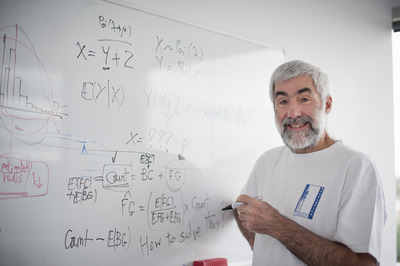
Professor Terry Speed from the Walter and Eliza Hall Institute for Medical Research will receive the $300,000 Prime Minister’s Prize for Science for a life’s work using mathematics and statistics to solve real-world issues. He has helped farmers, miners and criminologists and paved the way to modern biology and personalised medicine - interpreting the actions of thousands of genes. Today, he is using statistics to work out which cancers will kill you and which don’t need surgery.
A Fellow of the Australian Academy of Science since 2001, Professor Speed is head of bioinformatics at the Walter and Eliza Hall Institute of Medical Research, where he provides biologists with statistical tools to help them cope with the genetic revolution.
Twenty years ago, biologists looked at one or two genes in isolation. Today they can track the activity of thousands of genes in a single cell, but to understand the results they need tools such as Professor Speed develops.
During his time at the University of California, Berkeley, Professor Speed was one of the first to see the new technology of microarrays, where the activity levels of thousands of genes could be assessed simultaneously. Although data from this revolutionary technology was jealously guarded during its early development, he became one of the first statisticians to have access to it. As a result, he was able to develop simple statistical techniques for analysing microarray data that are still used in laboratories around the world.
Interestingly, many of the methods for which Speed is widely known do not necessarily rank highly in his own estimation. Of the microarray work, Speed says, “It wasn’t a major intellectual feat. It just happened to be the right thing at the right time.” Some of the papers of which he is most proud have almost never been cited by others.
In fact, his innate sense of fairness and his statistical skills have come together in a particular interest in criminology. He served at one time on the board of the Australian Institute of Criminology and was involved in three high-profile trials and hearings. The first came early in his career, while he was a tutor at Monash University. He testified that the trajectory of the fatal bullet made it unlikely that the last man hanged for murder in Victoria, Ronald Ryan, actually fired it. But his evidence made little difference to the outcome.
While at Berkeley, he became an expert witness at the trial of American footballer and actor OJ Simpson and also testified at a high-profile scientific misconduct hearing involving a student of US Nobel Laureate David Baltimore. The result of his brushes with the law is a conviction that a lot of forensic activity, including DNA fingerprinting, is underpinned by dubious statistical methods.
Currently, Professor Speed is focusing on techniques to sort out the thousands of differences between normal and cancer cells, to generate insights for treating cancer more efficiently, and working with industry to create a tool to determine if a thyroid growth is benign or not.
Frank Fenner Prize for Life Scientist of the Year - Associate Professor Angela Moles
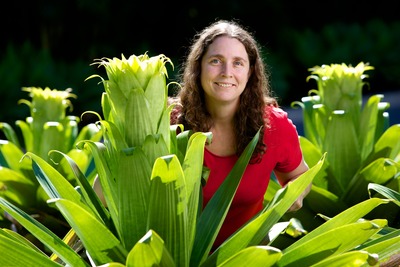
Associate Professor Angela Moles from the University of New South Wales (UNSW) received the $50,000 Frank Fenner Prize for Life Scientist of the Year. She is transforming our understanding of the plant world: where plant defence will be most aggressive; why plant seeds range from a speck of dust to a coconut; how ecosystems will adapt to a changing climate.
Much ecological theory was laid down in the 1960s and ’70s, Moles says. At that time, people tended to study a species or ecosystem they thought typical or representative - and then they generalised. And statistical techniques and the computational ability to handle data were far less developed than today. “Ideas that seemed logical became widely accepted without rigorous testing.”
Moles and others are now putting such ecological theory to the test, and much of it has been found wanting. But it’s hard for some ecologists to lay these ideas to rest.
“We now have this concept of zombie ideas. These are theoretical ideas proven wrong by data, but they have been accepted for so long that people keep peddling them. So you now have these ‘undead’ ideas wandering around the world feasting on the brains of unwitting undergraduates.”
For example, the conventional explanation for seed size was a simple trade-off. At one extreme, plants formed a few large seeds and justified the amount of resources they expended, because the chances of each seed growing into a plant were increased by carrying a nutrient supply to tide it through bad times. Tiny seeds, on the other hand, were disposable - millions made, but only one or two expected to take root.
Using data from thousands of species, Moles showed the picture was far more complex than a blend of these two different strategies for exploiting the environment. Seed size actually depends on a whole suite of factors, among them the size, life cycle and physiology of the plant, and its evolutionary history. In the end, not only did Angela publish groundbreaking new work on seeds, she was left with the beginnings of a database of plant characteristics and environmental data on which she has been building ever since.
Now a Queen Elizabeth II Fellow at the Evolution and Ecology Research Centre at UNSW, Moles’ database forms the basis of a huge study on how plants grow in the different latitudes and climates of the world, with respect to all sorts of characteristics such as height, leaf size, longevity and many others.
Malcolm McIntosh Prize for Physical Scientist of the Year - Associate Professor Andrea Morello
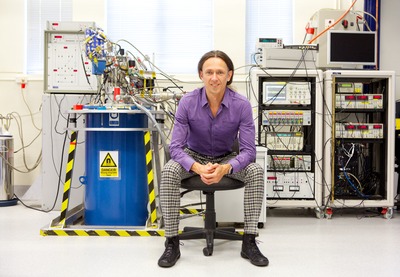
The $50,000 Malcolm McIntosh Prize for Physical Scientist of the Year was awarded to Associate Professor Andrea Morello from UNSW, who is making quantum computing a reality.
Morello came to Australia via Italy, France, the Netherlands and Canada. At each stop, he added to a unique set of skills in ultralow-temperature physics and the quantum behaviour of spin. By the time he reached UNSW, his experience fitted hand in glove with that of Professor Andrew Dzurak, an expert in the nanofabrication of semiconductors and director of the NSW node of the Australian National Fabrication Facility.
They became close collaborators, great friends and colleagues in the School of Electrical Engineering and Telecommunications at UNSW. Together they have constructed the means to read and write information in terms of the spin of an individual electron or nucleus of a single phosphorus atom in a silicon chip. The phosphorus atom is implanted in the chip by a team led by Professor David Jamieson at the University of Melbourne, using techniques developed for the electronics industry.
Ultralow temperatures are important to harness the quantum behaviour of spin. Just as you can change the natural orientation of a compass from north to south by adding energy - physically moving it against the grain - you can change the spin of an electron from up to down or vice versa. But the amount of energy it takes, even under a strong magnetic field, is very small - the equivalent of a temperature rise of about 1°C. So under normal conditions electrons flip back and forth spontaneously. But at a temperature of less than one degree above absolute zero, the spin can be frozen in place. And that is what Andrea has spent many years doing.
Prime Minister’s Prize for Excellence in Science Teaching in Primary Schools - Richard Johnson
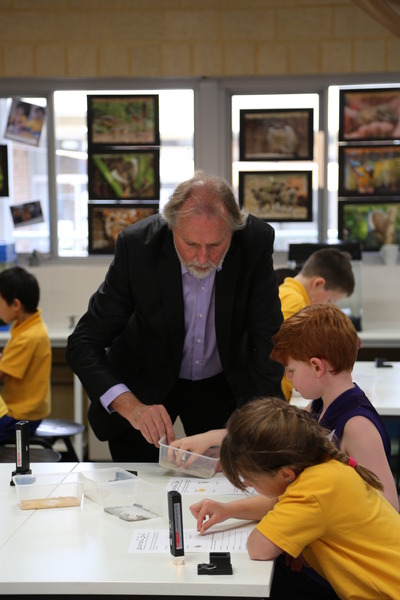
Richard Johnson from Rostrata Primary School has created a model science laboratory that makes science fun for students and for teachers. He received the Prime Minister’s Prize for Excellence in Science Teaching in Primary Schools. He and his school will share the $50,000 prize money.
Eight years ago, Johnson became involved with the West Australian Department of Education Primary Science Project and was appointed Specialist Science Support Teacher at Rostrata, where he had been teaching for nearly 20 years. He remodelled an old art room into a laboratory especially to teach science to primary students and began equipping it with all the latest technology he could get hold of. The students loved it.
Now more than 40 other WA schools have opened similar labs. Combined with the labs, Johnson’s website - Johnno’s Science (www. johnnosscience.com) - is inspiring thousands of teachers around the world with its ideas, resources and projects for teaching and learning primary-school science.
Prime Minister’s Prize for Excellence in Science Teaching in Secondary Schools - Sarah Chapman
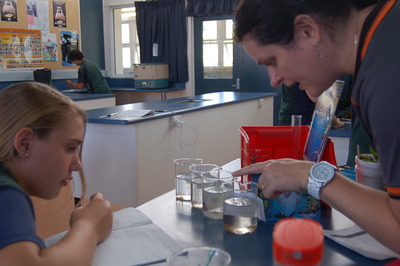
Sarah Chapman from Townsville State High School believes that students want real science that they can see and touch. Her students study the impact of the V8 Supercar races, held at the school and its environs, on nearby mangroves. She will receive the Prime Minister’s Prize for Excellence in Science Teaching in Secondary Schools, sharing the $50,000 prize money with her school.
Chapman’s teaching is almost always based on science related to daily life, and very much geared to her audience. The Middle School students, for example, do a series of experiments based around lollies. Among other things, they test the elasticity of jelly snakes and investigate the thermochemistry of chewing gum. And if things don’t turn out as hypothesised, you can always dream about eating your results.
As an extension program in Year 8, Chapman has been encouraging students to become involved in CSIRO’s CREST Program. CREativity in Science and Technology (CREST) is a non-competitive awards program that supports students in designing and carrying out their own open-ended science investigation or technology project.
How librarians can help maintain image integrity
By sharing best practice and providing useful resources, librarians can support researchers in...
Winners announced for 2025 Australian Museum Eureka Prizes
Now in their 35th year, the Australian Museum Eureka Prizes continue to highlight some of the...
"Damning" review of Forensic Science Queensland released
The review of the troubled forensic service provider reveals unreliable results,...





